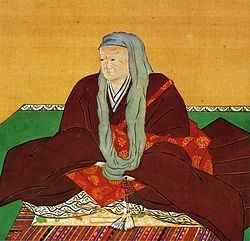Emperor Reigen (霊元天皇, Reigen-tenno, 9 July 1654 – 24 September 1732) was the 112th emperor of Japan, according to the traditional order of succession.
Reigen's reign spanned the years from 1663 through 1687.
Before Reigen's ascension to the Chrysanthemum Throne, his personal name (imina) was Satohito (識仁); and his pre-accession title was Ate-no-miya (高貴宮).
Reigen was the 16th son of Emperor Go-Mizunoo. His mother was the daughter of Minister of the Center Sonomotooto (内大臣園基音), Lady in Waiting Kuniko (新広義門院国子).
Regien's Imperial family lived with him in the Dairi of the Heian Palace. This family included at least 13 sons and 14 daughters:
Empress: Takatsukasa Fusako (鷹司房子) (Empress Dowager Shin-jyosai, 新上西門院)Third daughter: Imperial Princess Masako (栄子内親王)Lady-in-waiting: Bojo Fusako (坊城房子)Second daughter: Princess Ken'shi (憲子内親王)Lady-in-waiting: Daughter of Ogura Saneoki (小倉実起女)First son: Prince Saishin (済深法親王) (Buddhist priest)Lady-in-waiting: Matsuki Muneko (松木宗子) (Empress Dowager Keiho, 敬法門院)Fourth son: Imperial Prince Asahito (朝仁親王), also known as Tomohito (Emperor Higashiyama)Fifth daughter: Princess Tomiko (福子内親王)Sixth daughter: Princess Eisyu (永秀女王)7th son: Imperial Prince Kyogoku-no-miya Ayahito (京極宮文仁親王) – Sixth Kyogoku-no-miya7th daughter: Ume-no-miya (梅宮)8th daughter: Princess Katsuko (勝子内親王)8th son: Sei-no-miya (清宮)??: Atago Fukuko? (愛宕福子)Second son: Prince Kanryu (寛隆法親王) (Buddhist priest)Fourth daughter: Tsuna-no-miya (綱宮)??: Gojyo Yoko (五条庸子)Third son: San-no-miya (三宮)Fifth son: Prince Gyoen (尭延法親王) (Buddhist priest)Sixth son: Tairei'in-no-miya (台嶺院宮)??: Higashikuze Hiroko (東久世博子)11th son: Toku-no-miya (徳宮)12th son: Riki-no-miya (力宮)??: Daughter of ?? Sada'atsu (今城定淳女)13th son: Prince Sonsyo (尊賞法親王) (Buddhist priest)11th daughter: Princess Bun'o (文応女王)Consort: Daughter of Nishi-no-toin Tokinaga (西洞院時良女)First daughter: Chikoin-miya (知光院宮)Consort: Gojyo Tsuneko (五条経子)9th son: Saku-no-miya (作宮)10th son: Prince Syo'ou (性応法親王) (Buddhist priest)9th daughter: Princess Bunki (文喜女王)10th daughter: Princess Gensyu? (元秀女王)Consort: Irie Itsuko (入江伊津子)14th son: Kachi-no-miya (嘉智宮)12th daughter: Tome-no-miya (留宮)Consort: Daughter of Kurahashi Yasusada (倉橋泰貞女)15th son: Mine-no-miya (峯宮)Consort: Matsumuro Atsuko (松室敦子)16th son: Imperial Prince Arisugawa-no-miya Yorihito (有栖川宮職仁親王) – Fifth Arisugawa-no-miya13th daughter: Princess Yoshiko (吉子内親王)18th son: Prince Gyokyo (尭恭法親王) (Buddhist priest)Consort: Matsumuro Nakako (松室仲子)17th son: Prince Son'in (尊胤法親王) (Buddhist priest)Consort: Daughter of Hata ??tada (秦相忠女)14th son: Yae-no-miya (八重宮)His posthumous name was created during the Meiji Era by combining the kanji from the names of two previous Emperors, Emperor Korei (孝霊) and Emperor Kogen (孝元).
9 July 1653: The birth of an Imperial prince who will become known by the posthumous name of Reigen-tenno.1654: Prince Satohito, who is also known as Ate-no-miya, is named as heir before the death of his eldest brother, Emperor Go-Komyo; however, the young prince is considered too young to become emperor. It is decided that until the young heir grows older, his elder brother will accede to the throne as Emperor Go-Sai.5 March 1663 (Kanbun 3, 26th day of the 1st month): Emperor Go-Sai abdicated; and Prince Satohito received the succession (senso). Shortly thereafter, Emperor Reigen formally acceded (sokui) and his reign began.1665 (Kanbun 5, 6th month): Courts of inquisition were established in all the villages of Japan. These courts were charged with discovering and eliminating any vestiges of Christianity in each community.1666 (Kanbun 6, 4th month): Hokke shu Buddhist religious practices are preserved for those who believe that their spiritual and moral purity may be tainted by close association with others.1667 (Kanbun 7): After fire destroyed the main temple structure, work on rebuilding Nigatsu-do (二月堂) at Nara commenced.13 February 1668 (Kanbun 8, 1st day of the 2nd month): A great fire broke out in Edo—a conflagration lasting 45 days. The disastrous fire was attributed to arson.1669 (Kanbun 9):There was a famine in this year; and a military expedition was sent to northern Honshu against Shakushain's Revolt.1673 (Enpo 1): There was a great fire in Kyoto.21 May 1673 (Enpo 1, 5th day of the 4th month): The Chinese Buddhist teacher Ingen dies in the Obaku Zen temple, Mampukuji at Uji.1675 (Enpo 3): There was a great fire in Kyoto.4 June 1680 (Enpo 8, 8th day of the 5th month): Shogun Ietsuna dies; and he is succeeded by Tokugawa Tsunayoshi.15 June 1680 (Enpo 8, 19th day of the 5th month): Former-Emperor Go-Mizunoo died.1680 (Enpo 8, 8th month): A great flood devastates Edo.1680 (Enpo 8): Gokoku-ji is founded in Edo.1681 (Tenna 1): Tsunyoshi's investiture as shogun.5 February 1682 (Tenna 1, 28th day of the 12th month): A great fire sweeps through Edo.1681 (Tenna 2): A great famine devastates Kyoto and the surrounding area.1682 (Tenna 3): Tomohito-shinno is proclaimed Crown Prince; and the ceremonial investiture is held (after being in abeyance for over 300 years).26 March 1685 (Jokyo 2, 22nd day of the 2nd month): Former-Emperor Go-Sai died; and a great comet was observed crossing the night sky.2 May 1687 (Jokyo 4, 21st day of the 3rd month): Emperor Reigen abdicates in favor of his fifth son who will come to be known as Emperor Higashiyama.1687: Former-Emperor Reigen begins to rule as a cloistered emperor; and after abdication, Reigen's new home will be called the Sento-gosho (the palace for an ex-Emperor).1713: Former-Emperor Reigen enters a monastery under the name Sojo (素浄)24 September 1732 (Kyoho 17, 24th day of the 9th month): Reigen died; he was age 79.Emperor Reigen's memory is honored and preserved at his designated Imperial mausoleum (misasagi), Tsukinowa no misasagi at Sennyu-ji in Higashiyama-ku, Kyoto. His immediate Imperial predecessors since Emperor Go-Mizunoo – Meisho, Go-Komyo and Go-Sai are also enshrined along with his immediate Imperial successors, including Higashiyama, Nakamikado, Sakuramachi, Momozono, Go-Sakuramachi and Go-Momozono.
Kugyo (公卿) is a collective term for the very few most powerful men attached to the court of the Emperor of Japan in pre-Meiji eras. Even during those years in which the court's actual influence outside the palace walls was minimal, the hierarchic organization persisted.
In general, this elite group included only three to four men at a time. These were hereditary courtiers whose experience and background would have brought them to the pinnacle of a life's career. During Reigen's reign, this apex of the Daijo-kan included:
Sessho, Nijo Mitsuhira, 1663–1664Sessho, Takatsukasa Fusasuke, 1664–1668Kampaku, Takatsukasa Fusasuke, 1668–1682Kampaku, Ichijo Kaneteru, 1682–1687SadaijinUdaijinNadaijinDainagonThe years of Reigen's reign are more specifically identified by more than one era name or nengo.
Kanbun (1661–1673)Enpo (1673–1681)Tenna (1681–1684)Jokyo (1684–1688)
